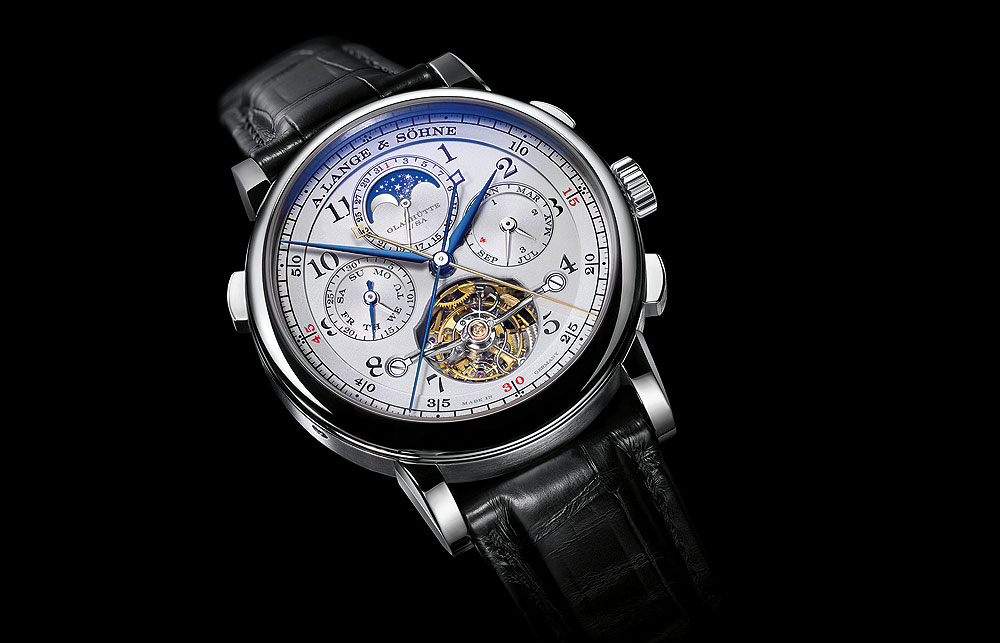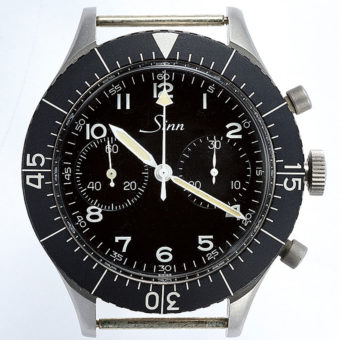A. Lange & Söhne unveiled the first Tourbillon “Pour le Merite” watch in its inaugural year of 1994, adding a chronograph to create an even more complicated model in 2005. This week, at SIHH, the Saxon brand takes it to yet another level of complexity by adding a perpetual calendar. Here’s the scoop on the Tourbograph Perpetual “Pour le Merite.”

The new watch is the fifth in the “Pour le Mérite” series, all of which feature a fusee-and-chain transmission system in their tourbillon movements. Fittingly, it combines five complications: the tourbillon, fusee-and-chain, chronograph, rattrapante, and perpetual calendar.
Integrating a perpetual calendar function into the existing Tourbograph movement presented a formidable challenge, as the additional mechanism had to be built around the tourbillon and thus only about two thirds of the movement surface were available. The entire caliber had to be redesigned in a manner that prevented energy loss and at the same time did not noticeably increase its thickness.
The dial is arranged in a traditional style, with Arabic numerals, a railway-track minute scale, blued steel hands for the time and rhodiumed gold hands for the calendar. The cloverleaf arrangement of the subdials is a tribute to the look of early Lange pocketwatches. The chronograph and rattrapante are controlled by a column wheel. The movement uses a screw balance and features two diamond endstones suspending the tourbillon cage and a black-polished tourbillon bridge. The platinum case has a diameter of 43 mm.

Lange’s new manufacture Caliber L133.1 is comprised of 684 parts, of which fully 206 are devoted to the perpetual calendar with its analog displays. It will correctly indicate the duration of each month until the last day of February 2100, when a one-time correction will be required — presumably by a descendant of this watch’s original owner. From that point, the calendar will again be correctly calibrated for the next 100 years. The three subdials display the date at 12 o’clock and day at 9 o’clock (indicated with rhodiumed gold hands) and the month and leap year together at 3 o’clock. The upper half of the date subdial also accommodates the moon-phase display, which is calculated to remain accurate for 122.6 years. The deep-blue moon disk is made of solid gold.
The chronograph’s start, stop, and reset are operated by two pushers on either of the crown, while a third button at 10 o’clock controls the split-seconds (rattrapante) function, whose functioning can be observed in action through the sapphire caseback. A pair of column wheels precisely controls both the gold-plated chronograph hand and the blued rattrapante hand, enabling the user to record multiple lap times during a complete revolution of the 30-minute counter at 9 o’clock.

The combination of tourbillon with fusée-and-chain transmission is meant to offset the effects of gravity and waning spring force in order to improve rate stability and rate accuracy: Caliber L133.1 is in fact the tenth movement developed by Lange that uses this delicately linked mechanism. The traditional black polishing on the tourbillon bridge, a complex finishing technique, is applied here the first time ever to a curved surface.
A technical hallmark of all “Pour le Mérite” timepieces (the name is a reference to a historical Prussian order conferred for exceptional scientific merit), the fusee-and-chain mechanism works thusly: via a fusee connected to the spring barrel with a chain, the force of the mainspring is delivered to the movement in constant increments thanks to the way in which the levers are harnessed. A planetary gearing mechanism inside the fusee ensures that the flow of power from the mainspring barrel to the escapement is not inter- rupted while the watch is being wound.
As one would expect, the finishing on the movement is of exquisite quality, including thermally blued screws, screwed gold chatons, Glashutte ribbing and perlage on the bridges and plates made of untreated German silver, and hand-engraving on the chronograph bridge. The A. Lange & Söhne Tourbograph Perpetual “Pour le Merite” is limited to only 50 pieces and priced at 480,000 euros.






